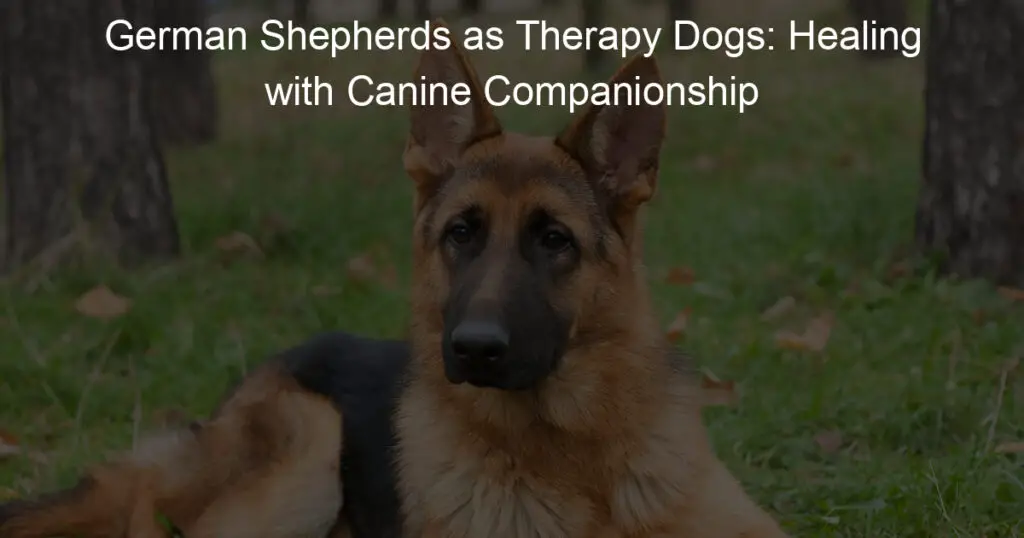The German Shepherd, a breed known for its loyalty, intelligence, and versatility, has evolved tremendously since its origins.
As a dog lover, I have always been fascinated by the history and changes this breed has undergone, from its first recognition in Germany to its widespread appeal today.
In this article, we’ll explore the development of this incredible breed and how it became the popular choice for various roles and responsibilities.
At the inception of the breed in the late 19th century, German Shepherds were bred primarily for their ability to work alongside humans in herding sheep and protecting flocks from predators.
The man responsible for their development, Captain Max von Stephanitz, had a vision of creating the ideal working dog – one with both brains and brawn.
As the breed evolved, German Shepherds played pivotal roles in both World Wars, where their abilities in various tasks demonstrated their adaptability, resilience, and intelligence.
Today, the German Shepherd is a beloved companion and an integral member of many families while also excelling in roles such as police and military work, search and rescue, and even therapy.
With their distinct characteristics, temperament, and penchant for learning, it’s no wonder that this breed continues to captivate hearts and minds across the globe.
Key Takeaways
- German Shepherds have a rich history, first bred for herding and adapting to various roles over time
- They played important roles in both World Wars and became popular in America
- Their unique characteristics, intelligence, and adaptability make them ideal for a range of jobs and responsibilities
The Evolution of German Shepherds
The German Shepherd has its roots in Germany, as the name suggests. Back in the late 1800s, Germany had various types of shepherd dogs for herding sheep.
Nevertheless, all these shepherding dogs varied significantly in terms of their appearance and abilities. There was a need to standardize these diverse shepherd dogs.
The Phylax Society was initially formed to address this matter, but unfortunately, it was disbanded a few years after its formation.
It was at this point when a passionate man named Max Emil Friedrich von Stephanitz stepped forward, determined to create the perfect herding dog.
Being a former member of the Phylax Society, my friend Max von Stephanitz dedicated his life to herding dogs. He believed in the importance of breeding dogs based on their working qualities rather than just their appearance.
As fate would have it, one day, Max encountered a striking and intelligent dog named Hektor Linksrhein at a dog show in Germany.
This meeting marked the beginning of a new breed that would ultimately be known as the German Shepherd.
I remember Max was so impressed by Hektor’s characteristics that he immediately purchased him and renamed him Horand von Grafrath.
From there, he started the German Shepherd Dog Club and began the process of standardizing the breed.
He selectively bred German Shepherd dogs to create the versatile, intelligent, and loyal breed we know today.
The first German Shepherds primarily came from two areas in Germany: Thuringia and Württemberg. Max carefully picked certain herding dogs from these regions to develop the unique features we associate with German Shepherds today.
By focusing on selecting dogs with strong traits such as intelligence, agility, and loyalty, Max von Stephanitz successfully transformed a rather varied group of shepherd dogs into the iconic breed we know and love.
German Shepherd in World Wars
As I explored the history of the German Shepherd, one of the most significant roles they played was during the World Wars.
In World War I, the breed was used extensively as a military asset. They assisted as messengers and mine detectors and even served alongside soldiers in the trenches.
Their intelligence and loyalty made them a perfect fit for these tasks.
During World War II, the German Shepherd’s involvement deepened, becoming an essential part of both the German and American militaries.
They continued to serve as messengers, but their roles expanded to include search and rescue operations and guard duty. One famous example is Adolf Hitler’s personal German Shepherd, Blondi.
Blondi was often featured in propaganda material, showcasing the dog’s loyalty and bravery. Unfortunately, since records show that she was killed by a cyanide capsule, Blondi’s story took a tragic turn.
The use of German Shepherds as war dogs during this time led to their widespread fame and increased popularity after the wars.
However, this fame came at a cost, as inbreeding became more common in an attempt to mass-produce dogs with specific traits.
Popularity in America
When I first learned about German Shepherds, I was amazed by how popular they’ve become in America. They were introduced to the United States in the early 20th century, and their fame grew rapidly.
One of the key factors in their rise to popularity was their introduction to the American Kennel Club (AKC) in 1908.
Being registered with the AKC made them a recognized and reputable breed, allowing for greater familiarity among potential dog owners.
As I dug deeper into the history of German Shepherds in America, I discovered that their popularity skyrocketed due to the influence of two remarkable dogs: Rin Tin Tin and Strongheart.
These German Shepherd actors took the nation by storm, starring in numerous silent films and captivating the hearts of Americans with their intelligence, loyalty, and heroism. They became true canine celebrities!
Rin Tin Tin, found by an American soldier in World War I, was brought to the United States, and his film career began in 1922. This wonderful dog starred in over 25 films and helped to further popularize the breed.
Strongheart, another German Shepherd actor, similarly contributed to the breed’s fame, starring in six successful films of his own.
That’s not all; their talents didn’t go unnoticed. These German Shepherd actors brought attention to the breed’s versatility and intelligence, making them a popular choice for many roles.
Police and military forces started using these dogs for search and rescue missions, detecting narcotics, and other critical tasks.
This, in turn, made the German Shepherd even more well-known and loved by the general public.
Nowadays, the German Shepherd remains one of America’s most popular dog breeds, and I can easily see why.
Their intelligence, versatility, and unwavering loyalty have secured them a cherished place in American hearts and homes.
Roles and Jobs of the German Shepherd
As a lover of German Shepherds, I must say that they are truly versatile dogs with a rich history of serving in various roles. Initially, German Shepherds were bred as herding dogs to protect and manage livestock.
Thanks to their intelligence, agility, and loyalty, they soon became popular working dogs in various fields.
In terms of alertness, German Shepherds are top-notch watchdogs. Their natural instinct to protect ensures that they are vigilant and responsive to potential threats.
Their size and strength also serve as effective deterrents for any intruders.
One of the most well-known jobs for German Shepherds is serving in the police force. Their ability to learn quickly and carry out tasks accurately makes them ideal for tracking, search and rescue missions, and narcotics detection.
Moreover, their courageous and protective nature makes them reliable partners for law enforcement personnel.
For similar reasons, German Shepherds have also been employed as war dogs throughout history. Their roles in the military have included messenger dogs, sentry dogs, and even mine detection dogs.
An interesting fact is that Geraldine Rockefeller Dodge, an American philanthropist, donated German Shepherds to the United States Marine Corps during World War II, highlighting their significance in military services.
In addition to their work in law enforcement and the military, German Shepherds have made significant contributions as service dogs.
They are often trained to assist individuals with disabilities, such as the visually impaired or mobility-impaired.
They have been known to excel in roles that involve guiding, retrieving items, and providing physical support for their handlers.
In conclusion, whether herding, serving as a watchdog, assisting in police operations, or working as a service dog, German Shepherds have proven themselves adaptable and invaluable in a variety of roles.
Their rich history and impact on society are testaments to their abilities and the potential they hold for fulfilling diverse working purposes.
Breed Characteristics and Appearance
As a dog enthusiast, I love exploring the various traits and features of different breeds.
For the German Shepherd, I can’t help but notice their impressive appearance and distinct characteristics.
Being one of the most recognizable breeds worldwide, the German Shepherd, also known as the Alsatian, showcases a muscular and athletic body.
Many people admire their elegant posture, which is one of the reasons they’re so popular among dog owners. When it comes to height and weight, male German Shepherds typically stand between 24 to 26 inches tall and weigh around 65 to 90 pounds.
On the other hand, female German Shepherds are a bit smaller, standing 22 to 24 inches tall and weighing approximately 50 to 70 pounds.
The German Shepherd’s coat is another remarkable feature worth mentioning. They have a double coat which consists of a dense, harsh outer coat and a softer undercoat.
These coats provide them with excellent protection against weather elements like cold temperatures and rain. Most German Shepherds sport two common coat variations – the short-haired and the long-haired.
The colors of their coats are quite diverse, with black and tan being the most popular, followed by sable, all-black, and a few other rare color variations.
Another prominent attribute of the German Shepherd is their intelligent and expressive eyes. Their eyes are usually almond-shaped and dark, which complements their overall appearance.
Furthermore, their ears are large, erect, and pointy, making their presence even more striking.
While the traits I mentioned are just a few aspects of the German Shepherd’s appearance and breed characteristics, it’s no wonder they’re widely loved and admired by people around the world.
They truly are a unique and distinctive dog breed.
The German Shepherd’s Temperament and Intelligence
I find that the German Shepherd is widely known for their loyal and obedient temperament. These traits make them remarkable partners for various jobs, from police work to search and rescue missions.
Their intelligence is undeniable, as they consistently rank among the top breeds for their ability to understand commands quickly.
In everyday life, I see that German Shepherds can be quite playful and even-tempered. They are very attentive to their surroundings, and their alertness is apparent whenever they pick up on new stimuli.
As highly intelligent dogs, they tend to enjoy engaging in various activities and love to be challenged mentally.
I’ve noticed that they thrive on regular training and stimulation to keep their minds sharp and healthy.
One way to assess a German Shepherd’s temperament is through a temperament test. This examination helps evaluate their reactions to different situations, such as showing an object they’ve never seen before or measuring their protective instincts.
When I’ve conducted these tests, I’ve found that German Shepherds generally exhibit a well-adjusted temperament.
Their keen intelligence and superb adaptability are evident, helping them maintain their composure even under pressure.
As someone who’s had the opportunity to interact with German Shepherds, I can say firsthand that their temperament and intelligence make them exceptional dogs.
They are steadfast and dedicated companions with an impressive ability to learn and adapt. Their remarkable qualities set them apart from many other breeds and make them wonderful additions to families or working environments.
Health Issues in the German Shepherd Breed
As a lover of German Shepherds, it’s crucial for me to discuss some health issues that these wonderful dogs can face throughout their lives.
I’ll cover some common health problems related to hip dysplasia, inbreeding, and eye disorders in the German Shepherd breed.
One of the most prevalent health concerns in German Shepherds is hip dysplasia. This genetic condition affects the dog’s hip joint, causing the femur head and hip socket to rub against each other instead of smoothly gliding.
Over time, this rubbing can lead to pain, arthritis, and even loss of mobility. To minimize the risk of hip dysplasia, responsible breeders test their dogs for the presence of this genetic trait and avoid breeding those with a higher risk.
Another significant issue in the German Shepherd breed is inbreeding.
In the quest to create outstanding dogs with specific traits, some breeders have chosen to mate closely related dogs (father to daughter, mother to son, or siblings), which can result in a higher occurrence of inherited health issues.
One such problem caused by inbreeding is a weakened immune system, making the dog susceptible to various illnesses.
To combat this, breeders need to focus on increasing genetic diversity within the breed.
German Shepherds may also face certain eye problems due to irresponsible breeding practices. One of these eye issues is Progressive Retinal Atrophy (PRA), which can cause gradual vision loss and eventually lead to blindness.
To minimize the risk of eye disorders, breeders should carry out genetic testing on future breeding dogs and avoid mating those with known eye problems.
In conclusion, while German Shepherds are a magnificent and intelligent breed, they can face some health issues.
Ensuring responsible breeding practices will help improve the overall health of the breed and allow them to continue being loyal companions for many years to come.
Training the German Shepherd
Training my German Shepherd is one of the most rewarding aspects of raising this intelligent and loyal breed. They are responsive and eager to please, making them highly trainable.
German Shepherds excel in various activities such as obedience, agility, search and rescue, and many more.
It’s important to start training my German Shepherd at an early age, just as they are starting to learn about the world around them.
Using positive reinforcement methods, I ensure that they associate good behaviors with rewards, such as treats and praise.
When it comes to exercise, German Shepherds need plenty of it due to their high energy levels. I introduce agility training into their routine, which provides both mental stimulation and physical exercise.
This can include tasks like jumping through hoops, navigating tunnels, and weaving through poles.
While training my German Shepherd, I am always patient and consistent with my commands. I break down tasks into smaller steps, making it easier for them to understand and learn.
With proper training and exercise, my German Shepherd is not only physically fit but also mentally sharp.
Conclusion
In conclusion, I have learned so much about the fascinating history of the German Shepherd breed.
From their origins as herding dogs, developed by Max von Stephanitz in Germany, to their rise in popularity both in Europe and America, the breed has undoubtedly proven its versatility and adaptability.
The German Shepherd’s reputation as a loyal, protective, and intelligent companion is well-deserved, and it’s no wonder they are still one of the most popular breeds around the world today.
I appreciate the efforts and dedication of the Verein für Deutsche Schäferhunde, the breed’s parent organization, in maintaining and upholding the breed standard, ensuring that the German Shepherd remains an excellent working dog with unparalleled strength, speed, and sense of smell.
The contributions of German Shepherds such as Rin Tin Tin and Prinz in popularizing the breed and showcasing their abilities in Schutzhund and police work were instrumental in shaping how we view these remarkable dogs.
While the Alsatian Wolf Dog and the White German Shepherd are fascinating variations of the breed, it is important to remember that the Deutscher Schäferhund, or standard German Shepherd, has long been a symbol of loyalty, strength, and dedication.
This multifaceted breed has a rich history, with roots in agriculture and herding, and has since expanded into diverse roles, such as tracking, protecting flocks, and serving as devoted companions in households around the globe.
In American history, the German Shepherd Dog has served a noble purpose as well. In fact, during World War I, these dogs were so celebrated for their work they were often referred to as America’s favorite war pet.
Similarly, the German Shepherd’s role in the police force continues to command respect and admiration.
As I look back on the German Shepherd’s journey, I am left with a sense of pride for this incredible breed, developed initially for herding duties and now revered for its many capabilities in a variety of roles, from working dogs to loving family pets.
The story of the German Shepherd is a testament to the enduring bond between humans and dogs and a constant reminder of just how valuable their contributions are to our lives.
Frequently Asked Questions
How did German Shepherds change over time?
Throughout their history, German Shepherds have seen many changes. They were originally developed as working dogs for herding and guarding sheep, which gave them the strong, agile bodies they are known for today.
As time went on, German Shepherds were employed for various roles like police work and assistance to people with disabilities.
This led to further changes in their size, coat length, and temperament. However, their intelligence and agility have always remained constant.
What is the common ancestor of the German Shepherd?
The common ancestor of the German Shepherd is believed to be a variety of European herding dogs, particularly those from Germany.
The modern German Shepherd breed was created through selective breeding of the finest herding and farm dogs from different regions in Germany.
By focusing on specific traits like intelligence, strength, and a strong work ethic, the breed was developed to fulfill a variety of tasks related to herding and guarding livestock.
When did German Shepherds arrive in America?
German Shepherds arrived in America during the early 20th century. The first German Shepherd was registered in the United States in 1908, and the breed quickly gained popularity due to their intelligence, loyalty, and versatility.
They rapidly became popular among dog enthusiasts and professionals, serving in various roles such as family pets, police dogs, and service animals.
What purposes were German Shepherds initially used for?
German Shepherds were initially bred for their exceptional abilities in herding and guarding livestock. Their agility, intelligence, and strong work ethic made them invaluable companions for farmers and shepherds in rural Germany.
As the breed developed, German Shepherds found new roles in other areas, such as police work, search and rescue missions, and eventually as service animals for people with disabilities.
Why do some people call German Shepherds Alsatians?
During World War I, the name “German Shepherd” fell out of favor in Britain and other allied countries due to negative connotations with Germany at the time.
As an alternative, they began referring to the breed as “Alsatian,” after the Alsace region in France.
Despite the name change, there is no difference between an Alsatian and a German Shepherd, as they are the same breed.
Today, both names are used interchangeably, but German Shepherd tends to be more widely recognized.
What other breeds influenced the development of the German Shepherd?
Several other breeds are thought to have contributed to the development of the German Shepherd.
Some of the most likely candidates include the Great Pyrenees, a large mountain dog known for its guarding capabilities; the Belgian Shepherd, which shares similar physical traits and working abilities; and the Old German Herding Dogs, which were native to different regions of Germany and were crossed to create the modern breed.
These breeds, among others, have helped shape the German Shepherd we know and love today.














